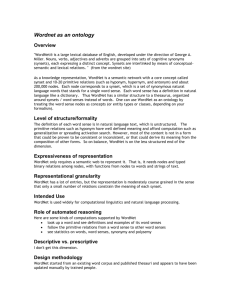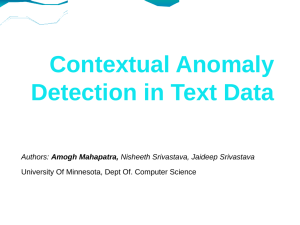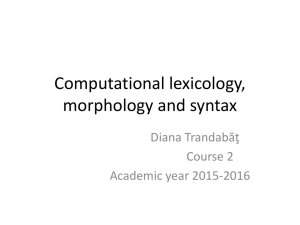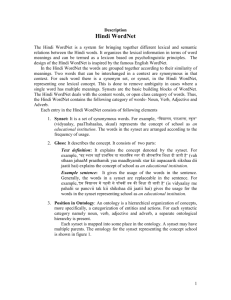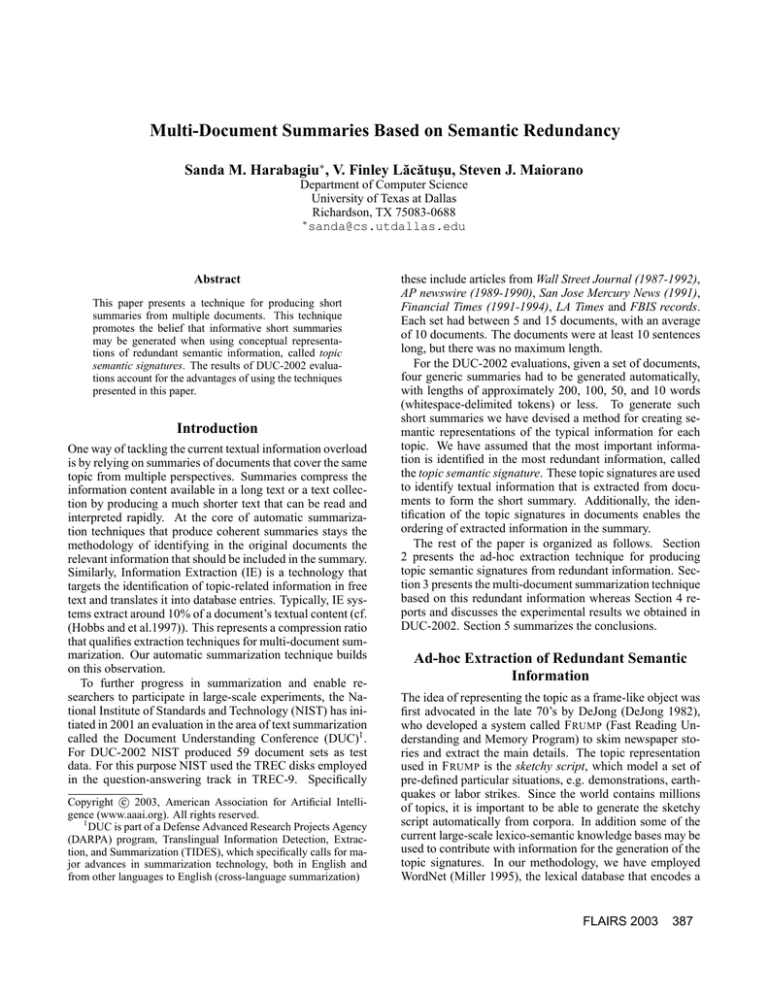
Multi-Document Summaries Based on Semantic Redundancy
Sanda M. Harabagiu∗ , V. Finley Lăcătuşu, Steven J. Maiorano
Department of Computer Science
University of Texas at Dallas
Richardson, TX 75083-0688
∗
sanda@cs.utdallas.edu
Abstract
This paper presents a technique for producing short
summaries from multiple documents. This technique
promotes the belief that informative short summaries
may be generated when using conceptual representations of redundant semantic information, called topic
semantic signatures. The results of DUC-2002 evaluations account for the advantages of using the techniques
presented in this paper.
Introduction
One way of tackling the current textual information overload
is by relying on summaries of documents that cover the same
topic from multiple perspectives. Summaries compress the
information content available in a long text or a text collection by producing a much shorter text that can be read and
interpreted rapidly. At the core of automatic summarization techniques that produce coherent summaries stays the
methodology of identifying in the original documents the
relevant information that should be included in the summary.
Similarly, Information Extraction (IE) is a technology that
targets the identification of topic-related information in free
text and translates it into database entries. Typically, IE systems extract around 10% of a document’s textual content (cf.
(Hobbs and et al.1997)). This represents a compression ratio
that qualifies extraction techniques for multi-document summarization. Our automatic summarization technique builds
on this observation.
To further progress in summarization and enable researchers to participate in large-scale experiments, the National Institute of Standards and Technology (NIST) has initiated in 2001 an evaluation in the area of text summarization
called the Document Understanding Conference (DUC)1 .
For DUC-2002 NIST produced 59 document sets as test
data. For this purpose NIST used the TREC disks employed
in the question-answering track in TREC-9. Specifically
c 2003, American Association for Artificial IntelliCopyright gence (www.aaai.org). All rights reserved.
1
DUC is part of a Defense Advanced Research Projects Agency
(DARPA) program, Translingual Information Detection, Extraction, and Summarization (TIDES), which specifically calls for major advances in summarization technology, both in English and
from other languages to English (cross-language summarization)
these include articles from Wall Street Journal (1987-1992),
AP newswire (1989-1990), San Jose Mercury News (1991),
Financial Times (1991-1994), LA Times and FBIS records.
Each set had between 5 and 15 documents, with an average
of 10 documents. The documents were at least 10 sentences
long, but there was no maximum length.
For the DUC-2002 evaluations, given a set of documents,
four generic summaries had to be generated automatically,
with lengths of approximately 200, 100, 50, and 10 words
(whitespace-delimited tokens) or less. To generate such
short summaries we have devised a method for creating semantic representations of the typical information for each
topic. We have assumed that the most important information is identified in the most redundant information, called
the topic semantic signature. These topic signatures are used
to identify textual information that is extracted from documents to form the short summary. Additionally, the identification of the topic signatures in documents enables the
ordering of extracted information in the summary.
The rest of the paper is organized as follows. Section
2 presents the ad-hoc extraction technique for producing
topic semantic signatures from redundant information. Section 3 presents the multi-document summarization technique
based on this redundant information whereas Section 4 reports and discusses the experimental results we obtained in
DUC-2002. Section 5 summarizes the conclusions.
Ad-hoc Extraction of Redundant Semantic
Information
The idea of representing the topic as a frame-like object was
first advocated in the late 70’s by DeJong (DeJong 1982),
who developed a system called F RUMP (Fast Reading Understanding and Memory Program) to skim newspaper stories and extract the main details. The topic representation
used in F RUMP is the sketchy script, which model a set of
pre-defined particular situations, e.g. demonstrations, earthquakes or labor strikes. Since the world contains millions
of topics, it is important to be able to generate the sketchy
script automatically from corpora. In addition some of the
current large-scale lexico-semantic knowledge bases may be
used to contribute with information for the generation of the
topic signatures. In our methodology, we have employed
WordNet (Miller 1995), the lexical database that encodes a
FLAIRS 2003
387
majority of the English nouns, verbs, adjectives and adverbs.
Extracting Topical Relations from WordNet
WordNet is both a thesaurus and a dictionary. It is a thesaurus because each word is encoded along with its synonyms in a synonyms set called synset, representing a lexical concept. WordNet is a dictionary because each synset
is defined by a gloss. Moreover, WordNet is a knowledge
base because it is organized in 24 noun hierarchies and
512 verb hierarchies. Additionally WordNet encodes three
meronym relations (e.g. H AS -PART, H AS -S TUFF and H AS M EMBER) between nouns and two causality relations (e.g.
E NTAILMENT and C AUSE -T O) between verbs. Additionally we noticed that chains of lexico-semantic relations can
be mined from WordNet to account for the connection between any pair of signature concepts of known topics. To
illustrate how such chains of relations can be mined, we first
consider two of the relations already encoded in WordNet
and then show how additional relations can be uncovered as
lexico-semantic chains between two concepts pertaining to
the same topic. We call these lexico-semantic chains topical
relations.
The sources of topical relations
In WordNet, a synset is defined in three ways. First it is
defined by the common meaning of the words forming the
synset. This definition relies on psycholinguistic principles,
based on the human ability to disambiguate a word if several
synonyms are presented. Second, the synset is defined by
the attributes it inherits from its super-concepts. Third, a
glossed definition is provided to each synonym. A G LOSS
relation connects a synonym to its definition. We believe
that glosses are good sources for topical relations, since they
bring forward concepts related to the defined synset. We
consider four different ways of using the glosses as sources
for topical relations:
1. We extend the G LOSS relation to connect the defined
synset not only to a textual definition but to each content
word from the gloss, and thus to the synset it represents.
For example, the gloss of synset {bovine spongiform encephalitis, BSE, mad cow disease} is ( fatal disease of
cattle that affects the central nervous system; causes staggering and agitation). A G LOSS relation exists between
the defined synset and fatal, disease, cattle, affect, central
nervous system, staggering and agitation.
2. Each concept from a gloss has its own definition, and thus
by combining the G LOSS relations, we connect the defined synset to the defining concepts of each concept from
its own gloss.
3. The hypernym of a synset has also a gloss, thus a synset
can be connected to the concepts from the gloss of its hypernym. Similarly to the I S -A relations, other WordNet
lexico-semantic relations can be followed to reach a new
synset and have access to the concepts used in its gloss.
Such relations may include H AS -M EMBER, H AS -PART
or E NTAILS and C AUSE -T O. Lexical relations based on
morphological derivations, if available may be used too2 .
2
WordNet 2 already encodes derivational morphology.
388
FLAIRS 2003
Morphological relations include the N OMINALIZATION
relations, known to be useful in IE.
4. A synset can be used itself to define other concepts, therefore connections exist between each concept and all concepts it helps define.
Figure 1 illustrates the four possible sources of topical
relations based on two of the WordNet relations, namely
G LOSS and I S -A.
Synset 2
Gloss
Synset 1
Synset 1
Gloss
Synset 3
Gloss
Gloss
Synset 3
Synset 4
Synset 2
Gloss
Gloss
Synset n
Synset n
Case 1
Gloss
Case 2
Synset 3
Synset 2
Synset 4
Synset 3
Synset 2
Gloss
Gloss
Gloss
IsA
Gloss
Synset 1
Synset n
Case 3
Synset 1
Gloss
Synset n
Case 4
Figure 1: Four sources of topical relations.
Topical relations as Paths between WordNet Synsets
Two principles guide the uncovering of topical relations.
First we believe that redundant connections rule out connections discovered by accident. Therefore, if at least two
different paths of WordNet relations can be established between any two synsets, they are likely to be part of the representation of the same topic. Second, the shorter the paths,
the stronger their validity. Consequently, we rule out paths
of length larger than 4. This entails the fact that each topic
may be represented by at least five synsets.
Figure 2 shows the topical relations produced by the paths
originating at the WordNet synset {mad cow disease} and
traversing concepts like {mental illness}, {agitation} or
{brain, mind}. It is to be noted that each concept may be
reached by at least two different paths of relations.
Gloss
mad cow disease
Gloss
Gloss
agitation
Gloss
cause
Is−A
disease
Is−A
central
nervous
system
Gloss
illness
Has−Part
brain, mind
Gloss
Is−A
Gloss
nature
diagnose/
diagnosis
Is−A
mental illness
Figure 2: Topical relations for the “mad cow disease” topic.
Topic Semantic Signatures
The representation of a topic can be viewed as a list of
semantic roles, each role being a slot that is filled by in-
formation extracted from text. The topical relations mined
from WordNet have the advantage that they bring forward
semantically-connected concepts deemed relevant to the
topic. However these concepts cannot be mapped directly
into a list of slots. First, WordNet was not devised with the
IE application in mind - it is a general resource of English
lexico-semantic knowledge. Because of this, some concepts
relevant to a given topic may not be encoded in WordNet.
Second, several WordNet concepts traversed by topical relations may be categorized under the same semantic role.
Third, some semantic roles may be encoded in WordNet at
a very abstract level, and thus they may never be reached
by topical relations. Fourth, some of the semantic roles derived from topical relations may never be filled, since there
is no corresponding information in the texts. To address all
these issues, we have developed a corpus-based technique
for creating ad-hoc lists of semantic roles for the topic signature representation for the collection. Our algorithm for
ad-hoc topic semantic signature generation was inspired by
the empirical approach for conceptual case frame acquisition presented in (Riloff and Schmelzenbach 1998).
Algorithm Ad-hoc Generation of Topic Semantic
Signatures
Step 1: Extract all sentences in which one of the concepts
traversed by topical relations is present. The concepts from
the topical relations are used as seed lexical items for the
identification of the signature slots.
Step 2: Identify all Subject-Verb-Object (SVO) +Prepositional attachments syntatic structures in which one of the
topical concepts is used. For this purpose, we used the the
Collins probabilistic parser (Collins 1996).
Step 3: Apply the C OCKTAIL coreference resolution system
(Harabagiu and et al.2001) and consider all the syntactic
SVO structures involving all coreferring expressions of any
of the nouns used in the syntactic structures discovered at
Step 2.
Step 4: Combine the extraction dictionaries with WordNet
to classify each noun from the structures identified at Step 2
and Step 3.
Step 5: Generate the semantic profile of the topic. For this
reason we compute three values for each semantic class derived at Step 4: (1) SFreq: the number of syntactic structures identified in the collection; (2) CFreq: the number of
times elements from the same semantic class were identified; and (3) PRel the probability that the semantic class
identifies a relevant slot of the signature. Similarly to the
method reported in (Riloff and Schmelzenbach 1998), PRel
= CFreq /SFreq. To select the signature slots the following
formula is used:
( CFreq > F1) or ((SFreq > F2) and ( PRel > P))
The first test selects roles because of the semantic categories
that are identified with high frequency, under the assumption
that this reflects a real association with the topic elaboration
in the collection. The second test promotes slots that come
from a high percentage of the syntactic structures recognized
as containing information relevant to the topic even though
their frequency might be low. The values of F1, F2 and P
vary from one topic to another - we derive them from the
requirement that a topic signature should not contain more
than 5 slots.
Multi-Document Summarization
We decided to use topic semantic signatures in combination with coreference information resulting from the resolution of anaphors, e.g. pronouns or other referential expressions. Every time the topic signature would match against
a text snippet, we would identify textual information to be
extracted, called topic snippet. Thus for each topic signature
Ti having the slots T Si1 , T Si2 , ..., T Sin we keep two additional forms of information: (1) the topic snippet T extSij
that matched one of of its slots T Sij ; and (2) all the entities
from the text that corefer with the information filling any slot
T extSij . Figure 3 illustrates a snapshot of populated topic
signatures and their mappings into topic snippets. The Figure illustrates some coreference chains as well. Coreference
information was obtained by using the C OCKTAIL system
(Harabagiu and et al.2001) on the texts.
Signature 1
Slot 1
Slot 2
....
Slot i
....
Slot n
Text 1
Text 2
Slot 1
Slot 2
....
Slot i
....
Slot n
Slot 1
Slot 2
....
Slot i
....
Slot n
Coreference
chain 1
Text 3
Signature 2
Signature 3
Coreference
chain 2
Coreference
chain 3
Signature 4
Slot 1
Slot 2
....
Slot i
....
Slot n
Figure 3: Mappings between topic signatures and topic snippets. Whenever a topic snippet contains an anaphor, pointers
to all other entities with which it corefers are kept in a coreference chain.
To generate multi-document summaries we use two observations: (1) the order in which relevant text snippets appear in the original articles accounts for the coherence of the
documents; and (2) to be comprehensible, summaries need
to include sentences or sentence fragments that contain the
antecedents of each anaphoric expression from relevant text
snippets. Since all articles contain information about a given
topic, it is very likely that a large percentage of the topic
signatures share the same filler for one of the slots. In the
case of the “natural disasters” topic, this filler was “ hurricane Andrew”. We call this filler the dominant event of the
collection. Additionally, we are interested in the topic snippets extracting information about other events that may be
compared with the dominant event in the collection. Thus
topic snippets are classified into three different sets: (a) S1
- snippets about the dominant event; (b) S2 - other snippets
corresponding to a topic signature that has a slot filled by the
dominant event; (c) S3 - other topic snippets.
FLAIRS 2003
389
Multi-document summaries of length L are produced by
extracting sentences from the document set in four different increments. The rationale for choosing four increments
is based on the four different summary lengths imposed by
the DUC evaluations, e.g. 50-word, 100-word, 200-word
and 400-word long summaries. Since it is not known apriori how many topic snippets are extracted nor what is the
cardinality of each Si set, for each summary increment we
perform at least one comparison with the target length L to
determine if the resulting summary needs to be reduced or
not. The multi-document summary is produced by the following algorithm:
Topic Signature-Based MD-Summarization (L)
Step 1: Select the most representative snippets.
To this end, for each topic signature T Si from Sj , with
1 ≤ j ≤ 4, for each slot T SSij we count the frequency
with which the same filler was used to fill the same slot of
any other signature. The importance of T Si is measured as
the sum of all frequency counts of all its slots. This measure generates an order on each of the four sets of templates.
Whenever there are ties, we give preference to the template
that has the largest number of mapped text snippets traversed
by coreference chains. Topic signature T S0 is the most important element from S1 . If S1 is null, the same operation is
performed on S2 .
Step 2: Summary-increment 1.
Select sentences containing the text snippets mapped from
T S0 in the order in which they appear in the text from
where T S0 is selected. If anaphoric expressions occur in
any of these sentences, include sentences containing their
antecedents in the same order as in the original article.
if length(summary) > L generate appositions for dates and
locations and drop the corresponding sentences.
if length(summary) > L drop coordinated phrases that do
not contain any of the mapped text snippets.
while length(summary) > L drop the last sentence.
Step 3: Summary-increment 2.
For each slot mapped into some other topic snippet from S1 ,
add its corresponding sentence/clause immediately after the
sentence mapped by slot T S0 . If anaphoric expressions occur in any of these sentences, include sentences containing
their antecedents in the same order as in the original article.
Continue this process until either (1) the length of the summary is larger than L − 1 or (2) there are no more sentences
to be added.
Step 4: Summary-increment 3.
Repeat step 3 for snippet from S2 .
Step 5: Summary-increment 4.
Repeat step 3 for snippet from S3 .
Evaluation
In DUC-2002 multi-document summarization involved 59
document sets. For each test data set the multi-document
summary generated by our system was compared with a
gold-standard summary created by humans. For each data
set, the author of the gold-standard summary assessed the
degree of matching between the model summary and the
summaries generated by the systems evaluated in DUC-
390
FLAIRS 2003
2002. Each of these measures were scored on a scale between 0 and 4.
Q1: About how many gross capitalization errors are there?
Q2: About how many sentences have incorrect word order?
Q3: About how many times does the subject fail to agree in number with the
verb?
Q4: About how many of the sentences are missing important components
(e.g. the subject, main verb, direct object, modifier) −causing the sentence
to be ungrammatical, unclear or misleading?
Q5: About how many times are unreleted fragments joined into one sentence?
Q6: About how many times are articles (a, an, the) missing or used incorrectly?
Q7: About how many pronouns are there whose antecedents are incorrect,
unclear, missing or come only later?
Q8: About how many nouns is it impossible to deterine clearly who or what
they refer to?
Q9: About how many times should a noun or noun phrase have been replaced
with a pronoun?
Q10: About how many dangling conjunctions are there ("and", "however" ...)?
Q11: About how many instances of repeated information are there?
Q12: About how many sentences strike you as in the wrong place because
they indicate a strange time sequence, suggest a wrong cause−effect
relationship, or just don’t fit in topically with neighboring sentences?
Figure 4: Qualitative questions used to evaluate summaries
in DUC-2002.
To compute the quantitative measures of overlap between
the system-generated summaries and the gold-standard summary, the human-created summary was segmented by hand
by assessors into model units (MUs), which are informational units that should express one self-contained fact in the
ideal case. MUs are sometimes sentence clauses, sometimes
entire clauses. In contrast, the summaries generated by the
summarization systems were automatically segmented into
peer units (PUs) - which are always sentences. Figure 5 lists
the results obtained for the multi-document summarization
evaluations. The Figure also lists the results of the evaluations with respect to the accuracy with which the summaries
responded the twelve questions listed in Figure 4. By ranking according to the mean coverage of PUs into MUs and
the respective median coverage, the results of our methods
were ranked on the first place. It also obtained the best rank
for mean-length adjusted coverage and for median lengthadjusted coverage.
For multi-document summaries, we considered also the
Precision and Recall measures. Precision is calculated as
the number of PUs matching some MU divided by the number of PUs in the peer summary, considering all summaries
automatically generated for the same collection. We have
obtained a precision of 20.66% and a recall of 20.70%. The
precision was ranked as the third one whereas the recall was
ranked as the first one among all the systems that participated in DUC-2002. As reported in (McKeown et al.2001),
this estimate of the precision is conservative, since the number of PUs that are considered correct can be increased by
considering information about the PUs not assigned to MUs.
Sample standard deviation of coverage scores
Mean length−adjusted coverage
Median length−adjusted coverage
Sample standard deviation of adjusted coverage scores
1
Median coverage
2
Mean coverage
6
0.39 4.19
Number of model units
2
0.32
Number of unmarked peer units
3
0.15
Number of marked peer units
6
0
Number of peer units
0.05
Fraction of unmarked peer units at least related to the model’s subject
0.17
Q12
3
0.07
Q11
4
0.11
Q10
1
Q9
1
Q8
1
0.02 0.014 0.08
Q7
Q2
0.07
Q6
Q1
0.32
Q5
Mean score for quality questions with non−0 answers
0.52
Q4
Count of quality questons with non−0 answers
1
Q3
Score for quality questins with non−0 answers
0.52
2.98
1.21
8.62
0.28
0.19
0.25
0.19
0.13
0.17
Ranks
3
1
2
1
1
1
1
1
Figure 5: Results of the multi-document summarization evaluations in DUC-2002.
Conclusions
In this paper we have shown that multi-document summarization of good quality can be obtained if topic signatures
can be generated automatically. Our method of generating topic semantic signatures combined WordNet semantic information with redundancy information from the documents. We have presented a multi-document summarization procedure that incrementally adds information to create
summaries of variable size. The decision of using incremental additions of sentences from multiple documents based on
mappings into topic snippets produced very good results for
coherence and organization in the DUC-2002 evaluations.
References
Michael Collins. A New Statistical Parser Based on Bigram Lexical Dependencies. In Proceedings of the 34th Annual Meeting
of the Association for Computational Linguistics, ACL-96, pages
184–191, 1996.
G. DeJong. An overview of the FRUMP system. In Stategies
for natural language processing, W. Lehnert and M. Ringle Eds.,
pages 149-176, Lawrence Erlbaum Associates, 1982.
S. Harabagiu, R. Bunescu, and S. Maiorano. Text and Knowledge
Mining for Coreference Resolution. In Proceedings of the 2nd
Meeting of the North American Chapter of the Association of
Computational Linguistics (NAACL-2001), pages 55-62, 2001.
D. Appelt, J. Hobbs, J. Bear, D. Israel, M. Kameyama, M. Stickel
and M. Tyson. FASTUS: A Cascaded Finite-State Transducer for
Extracting Information from Natural-Language Text. In Finite
State Language Processing, edited by Emmanuel Roche and Yves
Schabes, MIT Press, 1997.
K. McKeown, R. Barzilay, D. Evans, V. Hatzivassiloglou, M.Y.
Kan, B. Schiffman a nd S. Teufel. Columbia Multi-Document
Summarization: Approach and Evaluation. In Workshop Notes for
the DUC-2001 Summarization, pages 43–64, September 2001.
George A. Miller. WordNet: a lexical database for English. In
Communications of the ACM, Vol.38, No.11:39–41, 1995.
E. Riloff and M. Schmelzenbach. An Empirical Approach to Conceptual Case Frame Acquisition. In Proceedings of the Sixteenth
Workshop on Very Large Corpora , 1998.
FLAIRS 2003
391



